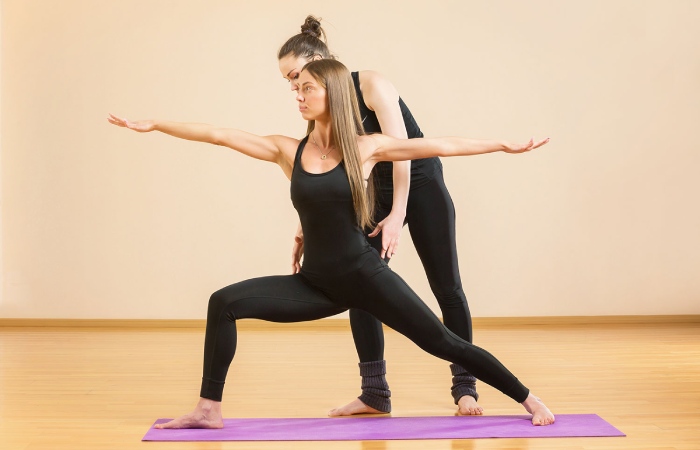Introduction
A yoga instructor is a teacher and guide who leads students through yoga practices that integrate physical postures, breathing exercises, and sometimes meditation to promote physical, mental, and emotional well-being. The role of a yoga instructor can be characterized based on the following qualities: a teacher who can lead a yoga class, create class sequences, teach breath work (pranayama), incorporate mindfulness and meditation, provide a safe and supportive environment, be a source of motivation, the qualities of a good yoga instructor, and the environment and employment opportunities. Yoga instructors can teach in a variety of locations, such as:
- Yoga studios and gyms.
- Yoga schools, community centers, and corporate offices
- Retreats, workshops, and private classes.
- Online classes through platforms or personal businesses
Being a yoga instructor is rewarding for those passionate about wellness, self-development, and helping others develop balance and well-being. This often goes beyond just teaching – it is a lifestyle that consists of embodying and sharing the benefits of yoga with others. Alongside these qualities, as a yoga teacher, it is essential to be certified by an internationally recognized yoga school. Therefore, we will focus on becoming certified yoga instructors.
To become a certified yoga instructor in 2025, here is a step-by-step guide covering everything from training to certification and practical experience:
Explore Different Yoga Styles

- Explore different yoga styles: Check out popular styles like Hatha, Vinyasa, Ashtanga, Iyengar, Kundalini, and Yin. Knowing which style best suits you will help you choose a workout.
- Take classes: Experiment with classes in different styles to gain hands-on experience and grow an understanding of each style’s approach and philosophy.
Choose a Yoga Teacher Training (YTT) Program
- Determine Certification Standards: Choose a 200-hour yoga teacher training program recognized by Yoga Alliance (YA) or a similar reputable organization, as these certifications are widely accepted.
- Determine Program Format: YTT programs can be completed in person, online, or hybrid. Choose the one that best fits your schedule and learning style.
- Determine Training Length: Standard certifications begin with 200-hour programs. Ensure the course covers asanas, anatomy, teaching techniques, philosophy, and hands-on training.
- Cost Budget: A 200-hour YTT program can range from $1,500 to $5,000. Consider additional costs if the training is residential or requires travel.
- Location: The title of “Yoga Capital” is often attributed to Rishikesh, a city in northern India situated at the foot of the Himalayas along the banks of the Ganges River. Rishikesh has been a spiritual and yoga hub for centuries, attracting yogis, gurus, and spiritual seekers worldwide. Therefore, you can opt for a 200-hour yoga teacher training in Rishikesh.
Begin Your Yoga Practice
- Establish a consistent practice: Commit to practicing regularly to build strength, flexibility, and awareness and to deepen your understanding of the practice.
- Document your progress: Keep a journal to track your growth, strengths, and areas for improvement. This can be a great reference during your training.
Enrol in a 200-Hour Teacher Training Program
- Dive deep into learning: Dive deep into each lesson, whether anatomy, philosophy, or sequence. Focus on hands-on classes where you can practice teaching.
- Peer Teaching Practice: Most programs include practice hours where you’ll receive feedback on your teaching style, adjustments, and communication.
- Build Connections: Interact with instructors and peers to strengthen relationships and build a support network within the yoga community.
Apply for Yoga Alliance Certification
- Register with Yoga Alliance: After completing the 200-hour program, you can convert a Registered Yoga Teacher (RYT) through Yoga Alliance.
- Submit training documentation: Provide proof of training and certification information to Yoga Alliance for verification.
- Pay your membership dues: Yoga Alliance charges an annual registration fee, so consider this part of your ongoing professional expenses.
Start Teaching Yoga
- Offer free or donation-based classes: Teaching friends, family, or local groups can help you practice your skills and gain confidence.
- Apply to studios and gyms: Many studios seek newly certified instructors to teach beginner classes.
- Create a routine: Take classes regularly to hone your skills, develop your voice as an instructor, and get feedback from your students.
Continue Your Education and Specialize
- Consider taking the 300-hour advanced training – a 300-hour program can deepen your knowledge and, when combined with a 200-hour certification, will lead to a 500-hour certification.
- Earn specialized certifications – If you are interested in specific areas, such as prenatal therapy, yoga therapy, or trauma-informed yoga, specialized certifications are available to expand your skills.
- Attend workshops and retreats – Participate in workshops, online courses, or yoga retreats to stay inspired, learn new techniques, and connect with other instructors.
Develop Your Professional Brand
- Create an online presence: Share your practice on social media, YouTube, or your website to connect with potential students and build your reputation.
- Create marketing materials: Consider developing a personal brand, including a logo, business cards, and class schedules for studios or private clients.
- Networking and collaboration: Contact other coaches and wellness professionals for recommendations and opportunities to co-host classes or workshops.
Stay Committed to Personal Practice and Self-Care
- Maintain your practice: Regular yoga practice will help you stay grounded and connected to what you teach.
- Seek mentorship and feedback: Learning from experienced teachers can improve your teaching style and help you grow professionally.
- Prioritize self-care: Teaching can be challenging, so prioritize time to recharge and maintain balance.
Following these steps, you can become a certified yoga instructor in 2025 and build a successful teaching career. This journey typically takes six months to two years, depending on your pace and commitment.


